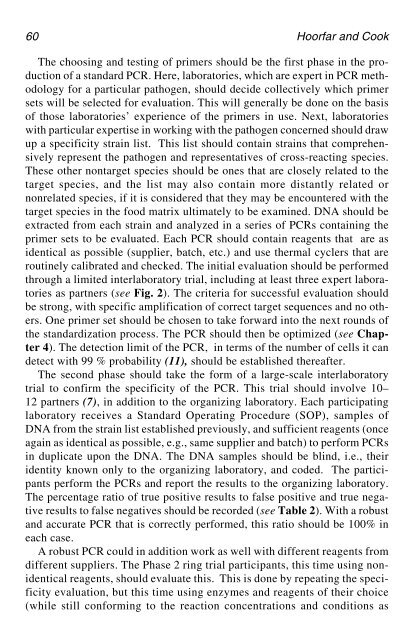PCR Detection of Microbial Pathogens PCR Detection of Microbial ...
PCR Detection of Microbial Pathogens PCR Detection of Microbial ...
PCR Detection of Microbial Pathogens PCR Detection of Microbial ...
You also want an ePaper? Increase the reach of your titles
YUMPU automatically turns print PDFs into web optimized ePapers that Google loves.
60 Hoorfar and Cook<br />
The choosing and testing <strong>of</strong> primers should be the first phase in the production<br />
<strong>of</strong> a standard <strong>PCR</strong>. Here, laboratories, which are expert in <strong>PCR</strong> methodology<br />
for a particular pathogen, should decide collectively which primer<br />
sets will be selected for evaluation. This will generally be done on the basis<br />
<strong>of</strong> those laboratories’ experience <strong>of</strong> the primers in use. Next, laboratories<br />
with particular expertise in working with the pathogen concerned should draw<br />
up a specificity strain list. This list should contain strains that comprehensively<br />
represent the pathogen and representatives <strong>of</strong> cross-reacting species.<br />
These other nontarget species should be ones that are closely related to the<br />
target species, and the list may also contain more distantly related or<br />
nonrelated species, if it is considered that they may be encountered with the<br />
target species in the food matrix ultimately to be examined. DNA should be<br />
extracted from each strain and analyzed in a series <strong>of</strong> <strong>PCR</strong>s containing the<br />
primer sets to be evaluated. Each <strong>PCR</strong> should contain reagents that are as<br />
identical as possible (supplier, batch, etc.) and use thermal cyclers that are<br />
routinely calibrated and checked. The initial evaluation should be performed<br />
through a limited interlaboratory trial, including at least three expert laboratories<br />
as partners (see Fig. 2). The criteria for successful evaluation should<br />
be strong, with specific amplification <strong>of</strong> correct target sequences and no others.<br />
One primer set should be chosen to take forward into the next rounds <strong>of</strong><br />
the standardization process. The <strong>PCR</strong> should then be optimized (see Chapter<br />
4). The detection limit <strong>of</strong> the <strong>PCR</strong>, in terms <strong>of</strong> the number <strong>of</strong> cells it can<br />
detect with 99 % probability (11), should be established thereafter.<br />
The second phase should take the form <strong>of</strong> a large-scale interlaboratory<br />
trial to confirm the specificity <strong>of</strong> the <strong>PCR</strong>. This trial should involve 10–<br />
12 partners (7), in addition to the organizing laboratory. Each participating<br />
laboratory receives a Standard Operating Procedure (SOP), samples <strong>of</strong><br />
DNA from the strain list established previously, and sufficient reagents (once<br />
again as identical as possible, e.g., same supplier and batch) to perform <strong>PCR</strong>s<br />
in duplicate upon the DNA. The DNA samples should be blind, i.e., their<br />
identity known only to the organizing laboratory, and coded. The participants<br />
perform the <strong>PCR</strong>s and report the results to the organizing laboratory.<br />
The percentage ratio <strong>of</strong> true positive results to false positive and true negative<br />
results to false negatives should be recorded (see Table 2). With a robust<br />
and accurate <strong>PCR</strong> that is correctly performed, this ratio should be 100% in<br />
each case.<br />
A robust <strong>PCR</strong> could in addition work as well with different reagents from<br />
different suppliers. The Phase 2 ring trial participants, this time using nonidentical<br />
reagents, should evaluate this. This is done by repeating the specificity<br />
evaluation, but this time using enzymes and reagents <strong>of</strong> their choice<br />
(while still conforming to the reaction concentrations and conditions as






